Looking to track your child’s teeth, but can’t keep up with which tooth is coming in or falling out? Hoping to capture every tooth moment in your kids’ lives, but do not know what to expect? Read on to see what you can expect and how to easily track your child’s teeth in a fun way.
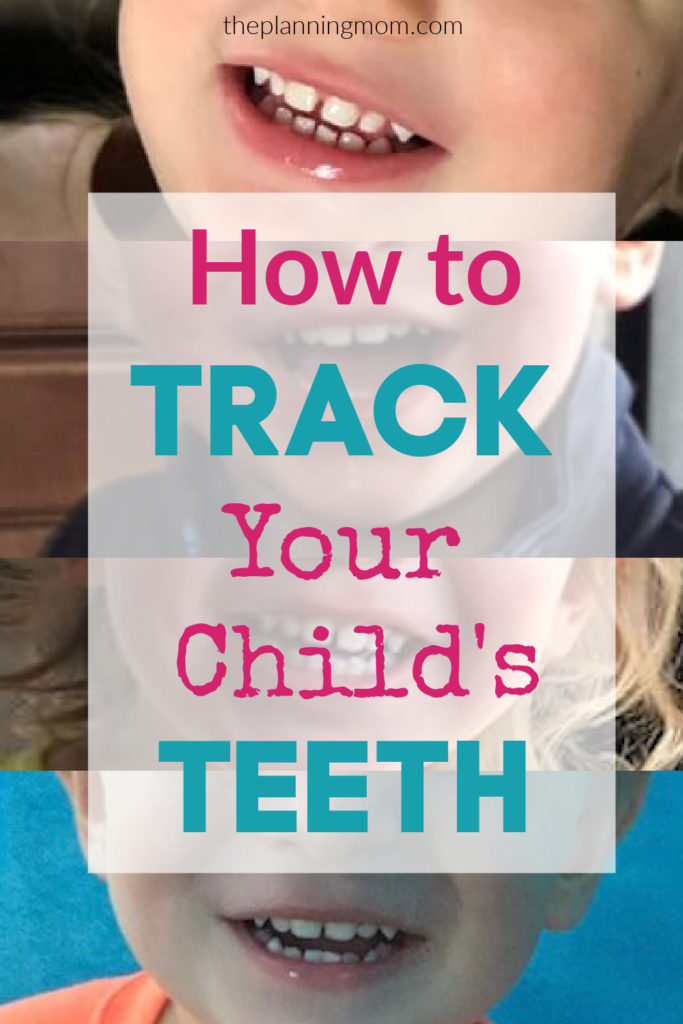
Getting and losing teeth is a big milestone for babies and kids. It signifies growth, changes their appearance, and functionality like what foods they can and cannot eat. From baby to adult, there always seems to be something teeth related going on.
Keep a Tooth Chart to Track Your Child’s Teeth
The easiest way to keep track of the teeth that your baby and child will be getting and losing is to use a tooth tracking chart. Each time a new tooth appears simply write in the date and age of your baby. Then, when your young child begins to loose teeth, write in the date and age each tooth is lost. Lastly, as new permanent teeth begin to come in write down the date and age. At the end you will have 3 tooth charts full of fun and helpful information.
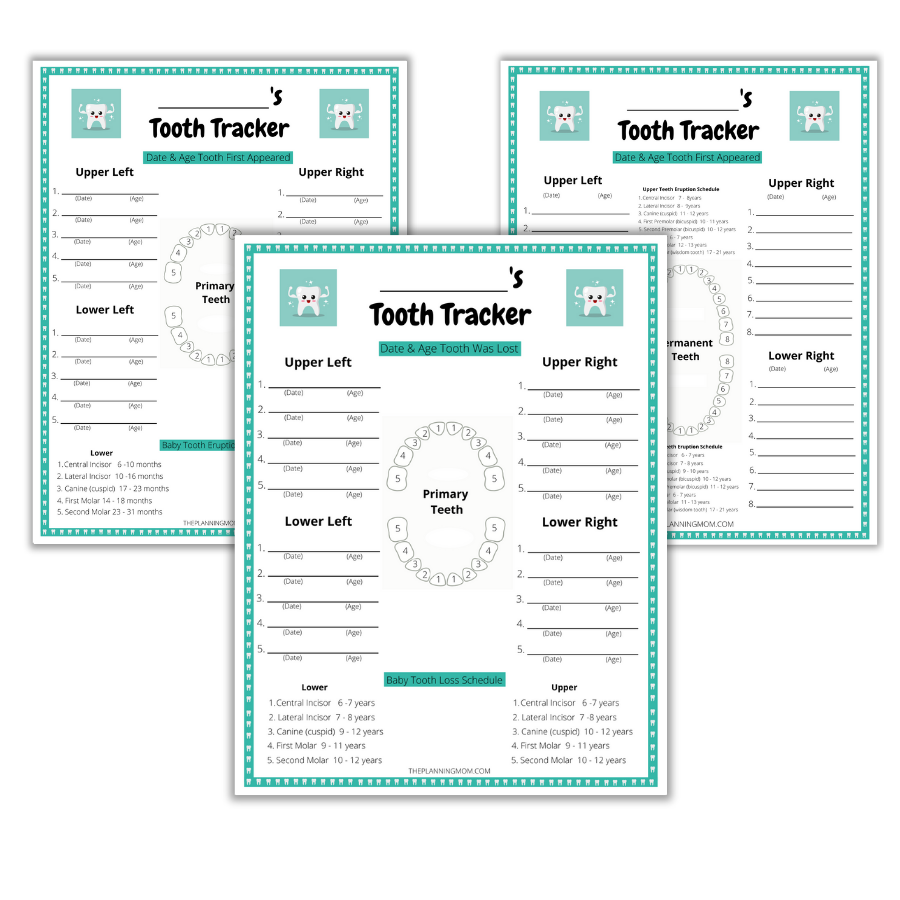
In addition to writing down the dates and ages, check out a tooth eruption and loss schedule to know when to expect these tooth changes. It is helpful to have a typical tooth schedule on the same page as your tooth tracker to easily see what to expect. Also, you are able to compare and potentially predict when your child will get their next tooth in by the trends.
Reasons to Use a Tooth Tracking Chart
- The dentist may ask when a child got or lost a tooth if there are issues or if permanent teeth are not coming in.
- In the event the dentist needs to pull a tooth they may ask when it came in.
- If your child needs braces the orthodontist may ask when certain teeth came in or fell out to plan when is a good time for braces.
- Predict when the next tooth is coming.
- I can be fun to look back when teeth came in and fell out.
- Compare to siblings or other kids.
It is important to track your child’s teeth and fun too. For more ideas on how to record your kid’s childhood moments and memories click here.
Track Baby Teeth as They Appear
Your baby will get 20 teeth in their mouth during the first 2 years of their life. Use a baby teeth chart to track these precious milestones each time a new tooth appears.
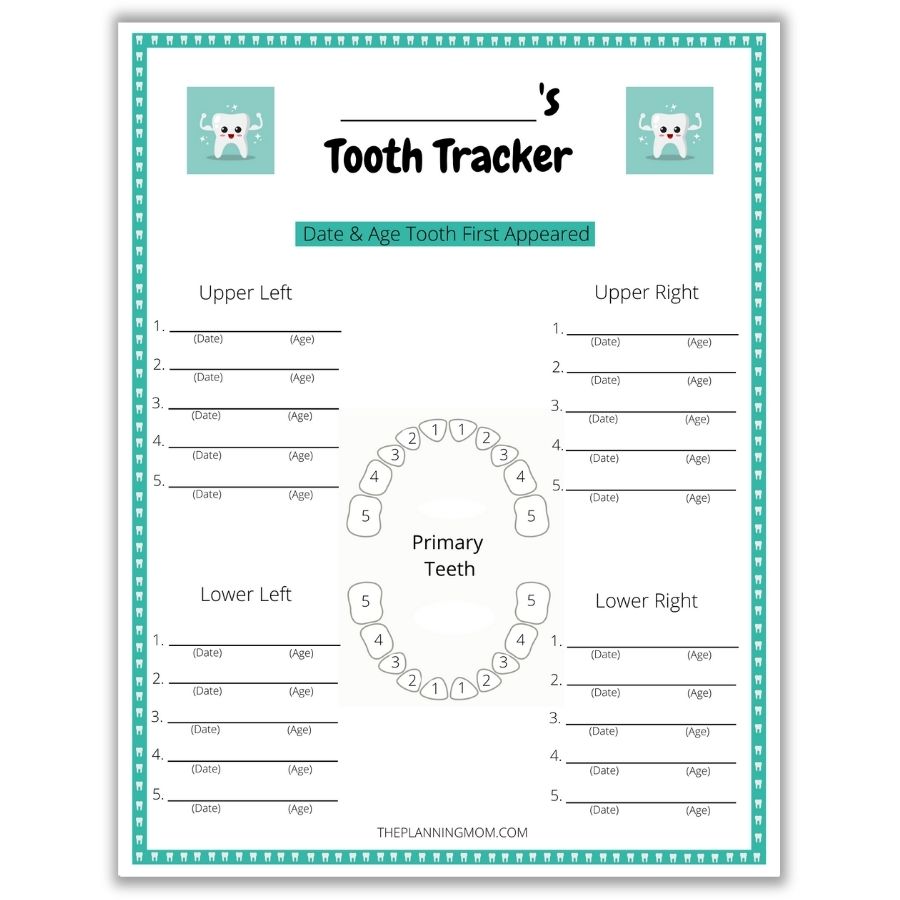
How to Know When Your Baby Is Getting Teeth
When a baby gets teeth it is exciting, but it can also be a very trying time. Some babies are greatly affected while teething, while others are hardly affected at all.
Some babies have symptoms or show signs when a tooth is coming in. Furthermore, some babies will show symptoms but they may not bother them at all. However, this can be a warming sign to you as a parent that they are getting teeth. On the other hand, some babies get symptoms that can have a huge affect on them, which also lets you know as a parent that a new tooth is coming in.
Teething Symptoms
If your baby is experiencing any of these symptoms they may be getting a new tooth.
- Fever
- Trouble sleeping
- Severe diaper rash
- Runny bowel movements
- Irritability
- Loss or change in appetite
- Excessive drooling or spitting
Both of my kids had similar symptoms for almost every tooth. This was helpful because then when they started experiencing these symptoms, I knew they were getting a tooth and experiencing some other sickness or issue.
Solutions for Teething Babies
There may not be anything that completely takes away the pain of a new tooth coming in, but here are some remedies that may temporarily relieve your baby’s tooth pain and stress for you:
- Gently massage your baby’s gums
- Put a teething toy in the freezer for a bit and then have them chew on that
- Rinse a washcloth with cold water and have your baby gnaw on that a while
- Wipe away the spit and drool from your baby’s mouth
- Only give your baby liquids or soft foods – nothing they have to bite or chew
- Get your baby some over the counter teething gel and wipe it on their gums
- Give your baby extra love and cuddles during this hard time
Be prepared as a parent to give your child some grace as their teeth are coming in. Give your child some extra comfort and support while they are going through the painful teething process.
The Most Painful Incoming Teeth For a Baby
Typically, the larger the tooth, the more painful the teething process is for your baby. The first and second molars are the largest teeth, so they will likely be the most painful teeth to come in. The molars erupting will most likely affect your child the most and they take the longest to fully come in. Actually, it makes sense the molars would be the most painful because they have to push through the most tissue and they take up the most space.
As with everything, all babies are different. Some babies will be in significantly more pain when their molars are coming in while with other babies you will hardly notice.
How to Track Lost Teeth
Use a baby teeth chart to track each tooth your kid loses. Record the date the tooth was lost and the age of your child. Losing a tooth is a big deal to a small child and an exciting time in their life. Record these special moments and memories in a tooth memory book.
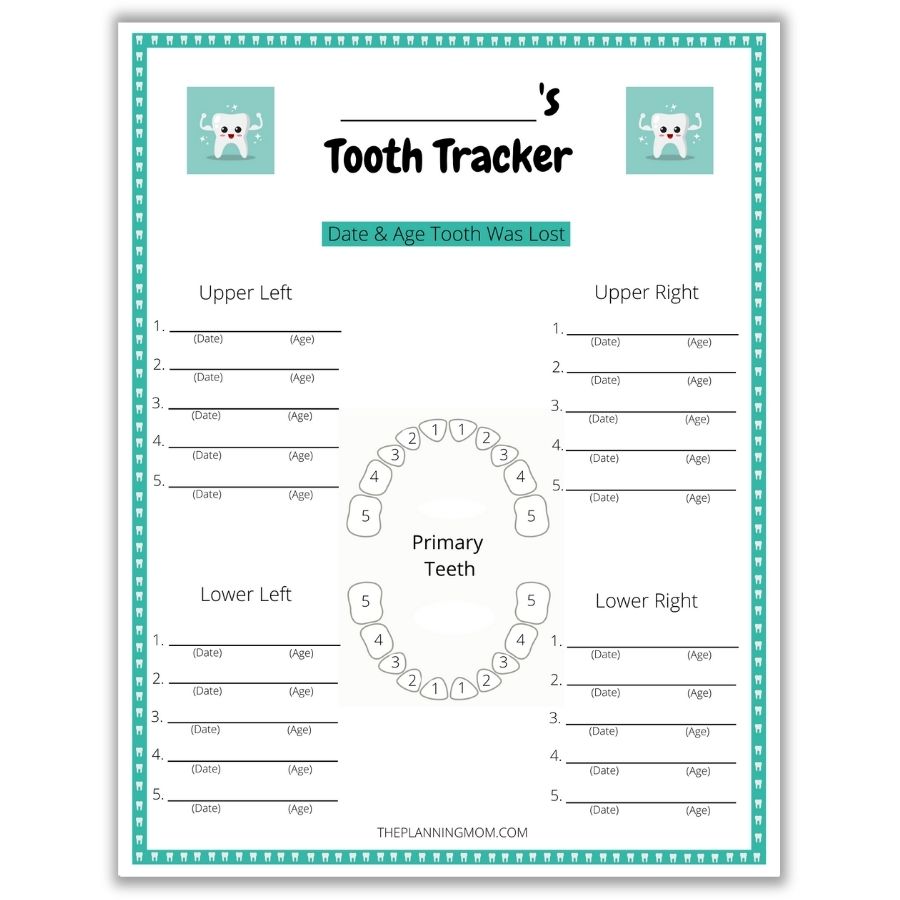
When Kids Start to Lose Their Baby Teeth
Kids can lose a tooth as early as 4 years old, but typically a kid loses their first tooth when they are 6-7 years old. Kids lose their teeth at all different ages so don’t worry if your child is 6 or 7 and they haven’t lost a tooth yet. If you are concerned, ask your child’s dentist at their next appointment. Ask if any of their teeth look loose or if they will be soon.
Losing teeth can at times be a frustrating experience for kids. A tooth can be loose for weeks without falling out.
If your child loses a lot of teeth around the same time eating, drinking and talking may become more difficult for a while. Serve them soft foods and foods they do not have to bite into or chew.
Make Losing Teeth Fun For Your Child
There are many ways to make losing teeth an exciting time for your child and a fun process. The traditional way is to have the tooth fairy come during the night and exchange money for the tooth. To make this experience more involved and special, have the child fill out a lost tooth report for the tooth fairy. Then have the tooth fairy leave a “receipt” for the tooth in addition to the money. Your child will get excited and have great memories of losing teeth with this tooth fairy experience.
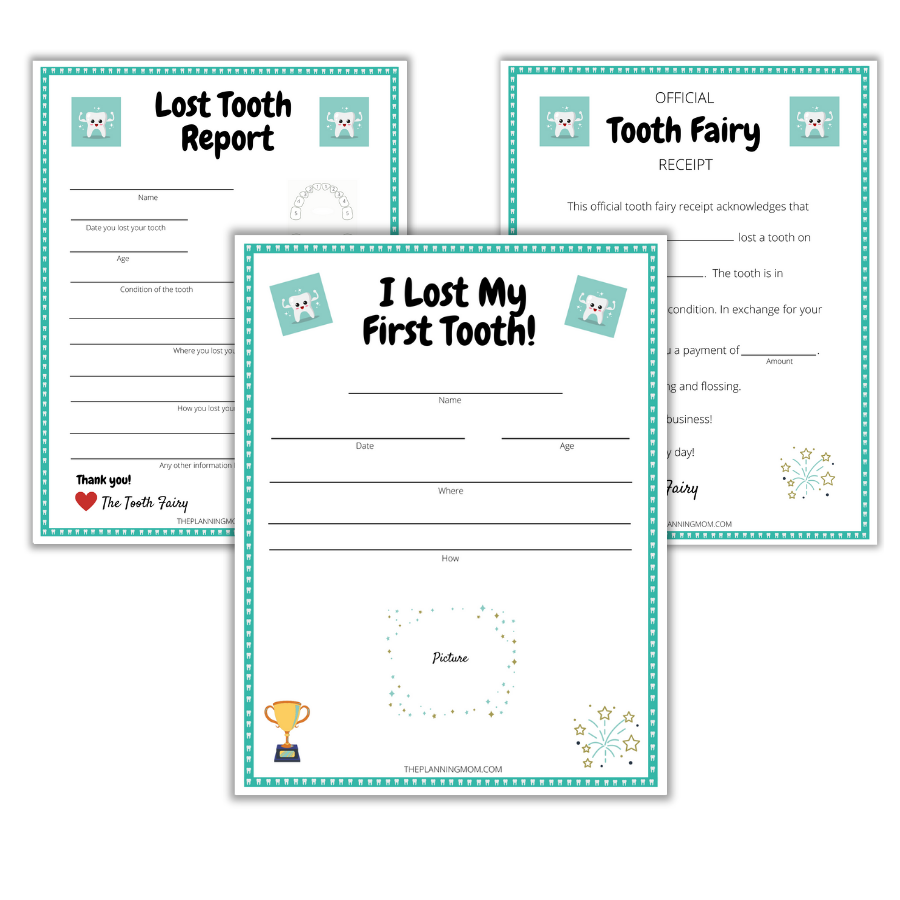
Take a picture of their face and mouth each time your child loses a tooth. This captures what they looked like for that short time without a tooth. It is fun to compare photos as they lose more teeth and their permanent teeth come in. Kids look so different with their baby teeth and permanent teeth! Note any other special memories along with losing the tooth or mementos of when or where it happened in the Lost a Tooth Memory Book.
Track Permanent Teeth As They Come In
There are actually 12 more permanent teeth that will come in than there were baby teeth. A total of 32 permanent teeth should appear in your child’s mouth. Track these teeth as they come in with a permanent tooth tracker.
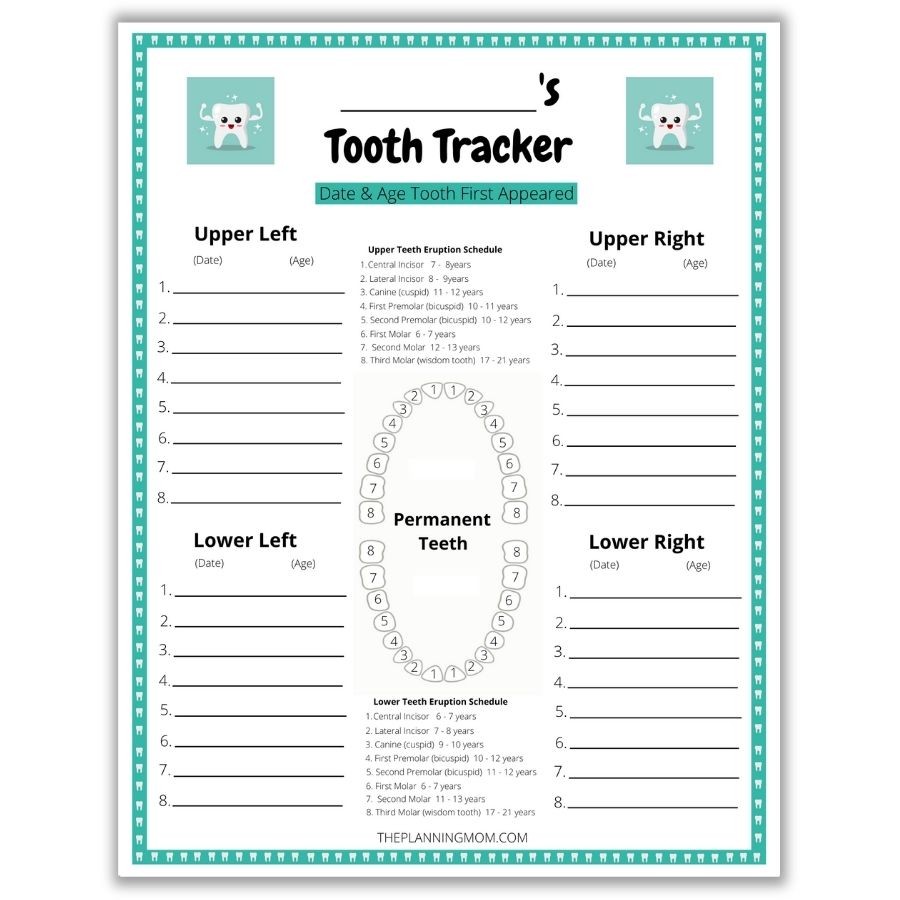
When Permanent Teeth Come In
Several weeks to several months is how long it takes for a new permanent tooth to come through. If the tooth has not appeared after 6 months of losing the prior tooth consult your child’s dentist.
The 2 top front teeth are the most noticeable when they are missing. (Have you ever heard of the song “All I want for Christmas is my 2 front teeth”). Just like the other adult teeth, it takes the 2 front teeth a few weeks to a few months to fully grow back in. While the 2 front teeth are missing, note your child will not be able to bite into many foods.
When to Expect Permanent Molars
Permanent molars do not wait to come in before all the baby teeth are gone. They are quite the contrary actually. Your child’s first permanent molars will start coming in when your child is just 6-7 years old.
The 2nd permanent molars wait a few more years to make their appearance. They will come in between age 11-13 years. Lastly, the third molar (known as the wisdom tooth) typically comes in between 17-21 years old.
What to Do If Permanent Teeth Are Not Coming In
In the event it is taking your child’s permanent tooth longer than 6 months to come in consult with your child’s dentist. However, do not panic. There are a number of reasons your child’s permanent teeth may not be coming in.
- The permanent teeth are growing in the wrong direction
- There is not enough room in your child’s mouth for all of the permanent teeth
- Not getting enough calcium
- Eating too many sugary foods and drinks
- Gender – girls generally see their permanent teeth come in faster than boys
- Hereditary slow teeth – if your parents or grandparents’ teeth were slow to come in, chances are your teeth may be slow to come in too
Your child’s dentist should be able to give you more guidance on the next steps regarding their permanent teeth.
Final Thoughts on Tracking Your Child’s Teeth
It is important to track your child’s teeth and the dates and ages teeth appear and fall out. Besides helpful information at times, it is fun to look back on these milestone moments and memories. Make tracking your child’s teeth fun with these cute and editable tooth trackers. Get your FREE baby tooth tracker by scrolling up to the top of this post.
For more fun and memorable family moments, grab your FREE birthday printables below.
Leave a Reply